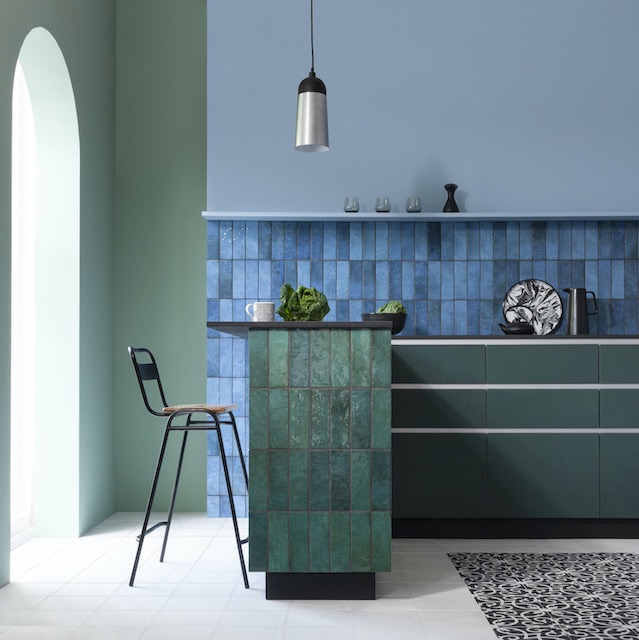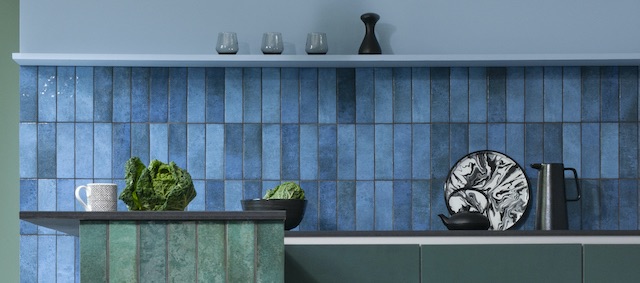. The kitchen in particular has a lot of surface area to be tiled, especially if you’re tiling floors and walls, and so it’s important to get it right. Getting your measurements wrong can mean extra costs further down the line for more tiles and even more labour time too. Not ordering enough tiles can also result in not having all your tiles from the same batch, which can mean the colouration may vary.
In conclusion, it’s not worth getting it wrong, so be sure to measure once, twice or even three times if you can!
We’ve put together our starting tips on how to measure for your
kitchen tiles. We would always recommend having some help from a tradesperson if you’re not sure about anything, or contacting someone in-store for advice.

What you’ll need to get started:
- A tape measure
- Something to write notes with
- Your phone, tablet or traditional notebook and pen will work!
- A calculator
- A helper
Measuring your kitchen floor
Most tiles are sold and measured using the decimal system and so it is best to work in centimetres, millimetres and metres.
Here are the steps you need to follow:
1. Decide where your perimeters are and mark exactly where you will be tiling to.
2. Measure the full length of the area you’ll be tiling on the floor - for ease, measure along a straight wall if you can. Note down the measurement in metres.
3. Now do the same with the width, using the perpendicular wall for ease. Note down the measurement in metres.
4. Multiply the two measurements together, this will provide you with the square meterage, so if your first measurement was 3.0 metres and your second was 2.5 metres, your total square metres required would be 7.5m2.
This is the most straightforward way of measuring a square or rectangular room. However, as we all know, our spaces aren’t always that straightforward! Kitchens in particular often have various nooks and corners where tiles will need to be cut to fit into the space. If you have a kitchen floor with a more complex footprint, here’s what you need to do:
1. Draw a floorplan of the entire room.
2. Divide your floor plan up into squares or rectangles, accounting for all areas - don’t miss any, no matter how small!
3. Now follow the measurement process above, but for each individual area and then add them all together at the end to get your total square metres.
Don’t forget to add on 10% to your final total area to allow for wastage. This 10% will cover any errors and cuts. A simple calculation will be to multiply your total square metre number by 1.1. So with the above example, if your total area was 7.5m2, you should look at buying tiles to cover 8.25m2 (7.5 x 1.1).
Individual tiles are measured in millimetres, and so it’s useful to have your measurements in millimetres too so that you can calculate how many tiles will be needed.
Measuring your kitchen walls
Measuring your kitchen walls follows a very similar process, the main difference is that you need to factor in any windows, doors, furniture and cabinetry that won’t need tiling.
Taking these elements into consideration, follow the same steps as above, starting with measuring the entire length and height of the wall in question. Once you have done this you can then calculate the areas that need to be discounted, such as windows etc. Calculate these areas as you would the tricky corners and areas of your floor (as explained above). Once you have calculated the square meterage of all these areas you simply subtract them from the overall wall area, you can then add on your additional 10% for wastage and you should have your final measurement!

Here are the steps to follow for measuring kitchen wall tiles:
1. Measure the entire wall space, the full length and height and note down the measurements in metres.
2. Multiply the two measurements together to give you the square meterage of the area.
3. Measure any windows, doors, cabinetry areas or any spaces that you will not need to tile in the same way (length x width) and note down each area’s square meterage.
4. Subtract the total square metre measurements of all the areas you want to discount from your first measurement of the entire wall area, this will give you your final measurement for tiling.
5. Don’t forget to add on the 10% to allow for wastage, use the calculation by multiplying by 1.1 to give you your total amount you need to order.
We hope we’ve shed some light on how to measure your kitchen tiles! If in doubt, make sure you ask a professional or contact us for some expert advice, we’d be more than happy to help! We also have a handy tile calculator that you might find useful!